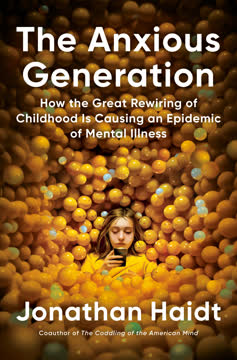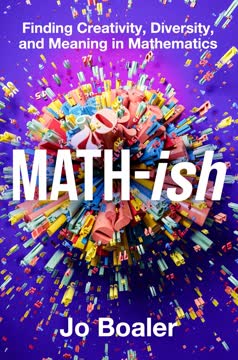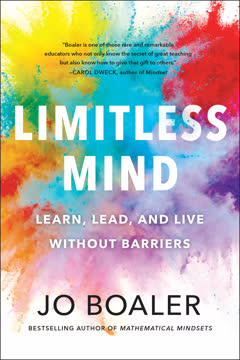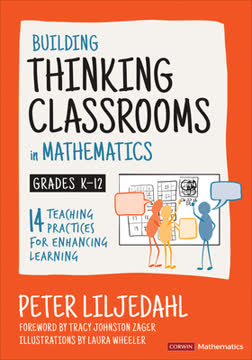Key Takeaways
1. Students Aren't Thinking: Traditional Classrooms Enable Non-Thinking Behaviors
Everywhere I went I saw the same thing—students not thinking and teachers planning their teaching on the assumption that students either couldn’t or wouldn’t think.
A pervasive problem. Initial observations in 40 diverse classrooms revealed a consistent issue: students were busy but not thinking deeply about mathematics. Teachers, facing curriculum demands and students who seemed unwilling or unable to think, often resorted to practices that facilitated content coverage without requiring genuine cognitive effort. This created a "non-thinking cycle."
Studenting behaviors. Research into "studenting" (what students do in a learning setting, some of which is learning) during common activities like "now-you-try-one" tasks exposed prevalent non-thinking behaviors. In one study, only about 20% of students actually tried the task on their own; the rest engaged in:
- Slacking (not attempting, distracted)
- Stalling (legitimate off-task behaviors like sharpening pencils)
- Faking (pretending to work)
- Mimicking (copying demonstrated examples)
Institutional norms. These non-thinking behaviors are enabled by deeply entrenched institutional norms in classrooms, such as desks in rows facing the front, students sitting while the teacher stands, and lessons following a predictable rhythm of teacher demonstration followed by individual practice. These norms signal expectations that often discourage risk-taking and independent thought, trapping both teachers and students in the non-thinking cycle.
2. Shock the System: Start with High-Impact Environmental Changes
The three practices in the first toolkit, when implemented together, shock the system, shocks the students, and necessitate a different behavior.
Break the cycle. To disrupt the non-thinking cycle and challenge institutional norms, a significant "shock" to the classroom system is needed. Implementing three key practices simultaneously creates enough departure from the norm that students notice and are prompted to change their behavior, allowing teachers to build a new culture of thinking.
The first toolkit:
- Use thinking tasks: Start with engaging, low-floor/high-ceiling tasks (like the Cats and Rats problem or card tricks) that require genuine problem-solving, not just mimicking.
- Frequently form visibly random groups: Group students randomly (e.g., using cards) every hour or so. This breaks social barriers, increases knowledge mobility, and prevents students from settling into fixed roles (like "the follower"). Optimal group size is 3 (K-2 is 2).
- Use vertical non-permanent surfaces (VNPSs): Have students work standing at whiteboards, windows, or other erasable vertical surfaces. This increases visibility of work, reduces anonymity, encourages risk-taking (easy to erase mistakes), and promotes collaboration.
Necessitate thinking. Implementing these three practices together creates an environment where slacking, stalling, faking, and mimicking become difficult or impossible. Students are put into situations where thinking is not just encouraged, but necessary for progress.
3. Refine Teacher Actions: Subtle Shifts in Delivery and Interaction Matter
The longer you talk, and the longer they listen, the less likely you are going to be able to get them to think.
Timing is crucial. When introducing a thinking task, the timing of its delivery significantly impacts student engagement. Waiting too long (more than 3-5 minutes) after starting the lesson allows students to settle into passive modes and increases the likelihood of teachers inadvertently "pre-teaching" the task, which undermines thinking.
Where and how. The physical location and method of task delivery also matter. Having students stand in a loose cluster around the teacher while the task is given verbally (with key details written on a VNPS) creates a higher-energy, more active environment compared to students sitting at desks. Verbal delivery cuts through the tendency to focus on decoding text and gets students to the mathematics faster.
Answering questions. Teachers spend significant time answering student questions (200-400/day), but most are "proximity questions" (asked because the teacher is nearby) or "stop-thinking questions" ("Is this right?"). Answering these is antithetical to building thinking. Teachers should primarily answer "keep-thinking questions" (clarification, extensions). A simple "smile and walk away" after a proximity or stop-thinking question, while initially frustrating, signals confidence in students and reduces reliance on the teacher.
4. Foster Student Independence: Shift Responsibility and Mobilize Peer Knowledge
Rather than being the source of knowledge in the room, teachers were working to mobilize the knowledge already in the room.
Autonomy is key. In a thinking classroom, where students work in groups on VNPSs, the teacher cannot be everywhere at once. Students need greater independence and responsibility for their own learning, which requires fostering autonomy. This means giving students choice in how they approach tasks and access resources.
Mobilize knowledge. Instead of always providing hints or the next task directly, teachers should direct students to leverage the collective intelligence in the room. This involves:
- Encouraging passive interaction (looking at other groups' work for ideas).
- Prompting active interaction (suggesting groups talk to each other when stuck or finished).
- Purposefully putting groups with different solutions or strategies together to discuss and debate.
Be deliberately less helpful. By strategically withholding direct answers and instead pointing students towards peer knowledge, teachers activate student autonomy. This reduces the number of hands raised, increases inter-group collaboration, and positions students as resources for each other, making the teacher's role more manageable and focused on groups truly needing support.
5. Rebrand Homework: Make it About Student Understanding, Not Compliance
We stopped calling it homework and started calling it check-your-understanding questions.
Homework is broken. Traditional homework often fails to achieve its intended purpose (checking understanding, learning from mistakes). Studenting research shows that when homework is marked, students frequently don't do it, cheat, or get help just to finish. When it's not marked, many still don't do it or simply mimic examples without thinking.
Shift the purpose. Rebranding "homework" as "check-your-understanding questions" shifts the focus from compliance and marks (for the teacher) to self-assessment and learning (for the student). This simple change, coupled with other practices, increases the number of students doing the questions for the right reasons.
Key changes:
- Do not mark or check these questions. Any policing shifts the focus back to the teacher.
- Provide answers at the same time the questions are given.
- Provide worked solutions later (e.g., the next day) to allow students to first try on their own and then compare their thinking.
- Frame the questions as an opportunity for students to see what they can do independently after working in groups.
Autonomy and choice. Students should have autonomy over whether and how they do these questions. While some may choose not to do them, the majority will engage, and those who do will be thinking about their learning, not just getting points.
6. Create Flow: Design Tasks and Use Hints/Extensions to Keep Students Engaged in Curriculum
The goal of building thinking classrooms is not to find engaging tasks for students to think about. The goal of thinking classrooms is to build engaged students that are willing to think about any task.
Engagement through flow. Drawing on Csíkszentmihályi's work, engagement (and thus thinking) happens when students are in a state of "flow," where the challenge of the task balances their ability. To keep students in flow, their ability must increase, requiring the teacher to increase the challenge.
Maintaining flow asynchronously. In a thinking classroom, flow must be managed asynchronously for groups. This requires:
- Thin slicing: Creating sequences of curricular tasks that increase in challenge incrementally, varying only one element at a time (like the factoring quadratics or algebra sequences).
- Extensions: Giving groups the next, slightly harder task when they are ready, or encouraging them to "steal" the next task from other groups working ahead.
- Hints: Providing support when groups are frustrated. Hints can decrease challenge (e.g., partial answer) or increase ability (e.g., suggest a strategy). Ability-increasing hints are more powerful long-term.
Modes of engagement. Challenge can also be increased by shifting a group's mode of engagement with the same task: from doing, to justifying, to explaining, to teaching, to creating. This provides ways to challenge even the strongest groups.
7. Consolidate Learning: Reify Collective Thinking into Individual Understanding
Rather than explaining one’s own work, trying to decode someone else’s work changes consolidation from telling to thinking.
Beyond leveling to the top. Traditional consolidation often involves the teacher demonstrating the "best" solution, which disengages students who are not at that level and encourages mindless note-taking. This "leveling to the top" is ineffective for learning.
Consolidate from the bottom. In a thinking classroom, consolidation should start with the solutions or strategies that most groups achieved and move upward through increasingly complex levels, mirroring the flow sequence. This keeps more students engaged as the discussion starts with what they know.
Effective methods:
- Guided gallery walk: Students stand and walk to different VNPSs to discuss selected student work. This is most effective.
- Teacher-led discussion: Teacher leads discussion, either without writing or while writing on a board.
- Keep students standing and moving: This maintains engagement during consolidation.
Decoding peer work. Instead of having groups explain their own work (which others often tune out), ask other students to explain what a group was thinking based on their work on the board. This necessitates thinking and helps students decode mathematical ideas from written traces.
8. Meaningful Notes: Shift from Mindless Copying to Purposeful Recording
Notes to their future forgetful selves is the essence of mindful (as opposed to mindless) and meaningful (as opposed to meaningless) note taking.
Notes as thinking. Traditional note-taking (I-write-you-write, fill-in-the-blank) is often a mindless activity where students copy without understanding and rarely use the notes later. To make note-taking a thinking activity, it must be meaningful and for the student's own future use.
Notes to future forgetful selves. Prompt students to write down what they will need to remember in three weeks. This encourages them to select important information and process it in a way that makes sense to them.
Scaffolding meaningful notes:
- Use graphic organizers (cells for space constraints, demarcation, or pre-labeled categories like vocabulary, procedures, examples).
- Explicitly encourage worked examples and annotation.
- Develop competencies in creation, annotation, and selection of examples.
- Provide feedback by giving tasks later that require using the notes.
Individual reification. Meaningful notes are a vital step in transferring the collective understanding gained in group work into individual knowledge. They are by the student, for the student, and should not be marked or policed, as this shifts the purpose back to the teacher and encourages mindless compliance.
9. Evaluate What You Value: Assess Competencies Like Perseverance and Collaboration
We need to put our evaluation where our mouth is. We need to start evaluating what we value.
Beyond content. Teachers consistently identify competencies like perseverance, willingness to take risks, and collaboration as crucial for student success, but traditional evaluation focuses almost exclusively on content mastery. Evaluation should reflect what we truly value.
Observational rubrics. Use simple, co-constructed 2 or 3-column rubrics to evaluate observable student actions (not just their finished work) related to these competencies. These rubrics should:
- Focus on one competency at a time.
- Use dichotomous language (e.g., "giving up" vs. "not giving up").
- Replace column headings with arrows to emphasize continuum over fixed levels.
- Be co-constructed with students using T-charts ("What does good perseverance look like? What does bad perseverance look like?").
Impactful feedback. Present the rubric and state you will be evaluating a few groups. This signals value. Have groups self-evaluate using the rubric. This process, even without recording grades, significantly improves student behavior related to the evaluated competency because students see that their actions are noticed and valued.
10. Navigate Learning: Help Students See What They Know and What's Next
For many of these students, the knowledge of where they were and where they were going was all they needed to help them improve.
Clarity in learning. Students need to know "where they are" (what they understand/can do) and "where they are going" (what they still need to learn). Traditional feedback often fails to provide this clarity, especially for students who see a unit as one big topic rather than a collection of subtopics.
Navigation instruments. Create instruments (tables) that explicitly list the learning outcomes (subtopics) for a unit and break them down by complexity level (basic, intermediate, advanced). Populate these tables with specific questions or question numbers from quizzes, tests, or check-your-understanding questions.
Data-driven self-assessment. Students use symbols (✓, S, H, G, ✗, N) to record their performance on each question within the table. This provides a clear, data-based picture of their attainment for each outcome at each complexity level, helping them see exactly what they know and what they still need to work on.
Empowering students. This clarity empowers students to take responsibility for their learning, focus their efforts, and "level up" their understanding. It shifts self-assessment from opinion-based to data-based, making it a powerful tool for informing learning.
11. Grade Based on Data: Shift from Points to Evidence of Learning Over Time
The reorganization of points into data allowed the teachers to let go of outliers and early-not-knowing.
Beyond point-gathering. Traditional "event-based" or "point-gathering" grading (summing points from tests, quizzes, etc.) is neither objective nor accurate. It punishes early-not-knowing and fails to capture learning growth or the nuances of collaborative work and day-to-day understanding.
Data-gathering paradigm. Shift to an "outcomes-based" or "data-gathering" paradigm. Use instruments (like the navigation tables) to record evidence of student learning for each outcome at different complexity levels over time. Data can come from tests, quizzes, observations (O), conversations (C), individual work (✓, S, ✗, N), or group work (G).
Analyzing data. Analyze the data to determine the highest complexity level a student has consistently demonstrated for each outcome (e.g., two consecutive positive data points). Assign points based on this demonstrated level (e.g., Basic=2, Intermediate=3, Advanced=4). This honors mastery and learning growth.
Accurate and fair. This approach provides a more accurate and fair reflection of what a student has learned by focusing on demonstrated attainment over time, rather than aggregating performance across discrete events. It allows for the inclusion of collaborative work and day-to-day evidence, aligning grading with the practices of a thinking classroom.
12. The Framework Sequence: Implement Practices in a Specific Order for Success
What emerged from this experimentation was what I came to call the Building Thinking Classrooms Framework.
Pseudosequential implementation. Building a thinking classroom is not about implementing practices randomly, but following a pseudosequential order grouped into four toolkits. Starting with the right practices is crucial for success.
The Four Toolkits:
- Toolkit 1 (Shock the System): Implement thinking tasks, visibly random groups, and VNPSs simultaneously. This disrupts norms and necessitates new student behaviors.
- Toolkit 2 (Fine Tuning): Implement practices like when/where/how tasks are given, answering questions, fostering autonomy, check-your-understanding questions, and defronting the room. Order within this toolkit is flexible, but establish each practice before adding others.
- Toolkit 3 (Flow & Content): Implement flow (hints/extensions), consolidation, and meaningful notes in this order. This is where you apply thinking to curriculum and cover content efficiently.
- Toolkit 4 (Assessment): Implement evaluating what you value, helping students navigate learning, and grading based on data. Order is flexible, except grading based on data must follow navigation instruments.
Building momentum. This sequence builds momentum, starting with high-impact changes that shift student behavior (Toolkit 1), then refining teacher practices (Toolkit 2), applying thinking to content (Toolkit 3), and finally aligning assessment with the new culture (Toolkit 4).
Last updated:
Review Summary
Building Thinking Classrooms in Mathematics, Grades K-12 has received overwhelmingly positive reviews from educators. Readers praise its practical strategies for transforming math classrooms, emphasizing student engagement and critical thinking. Many teachers report significant improvements in student performance and classroom dynamics after implementing the book's methods. The 14 practices outlined are seen as revolutionary, challenging traditional teaching approaches. While some critics argue against its constructivist approach, the majority of reviewers consider it a must-read for math teachers, with potential applications in other subjects as well.
Similar Books







Download PDF
Download EPUB
.epub digital book format is ideal for reading ebooks on phones, tablets, and e-readers.




